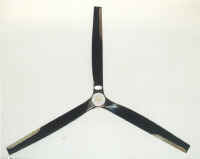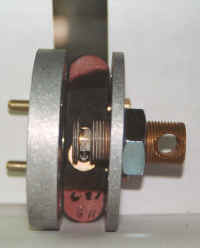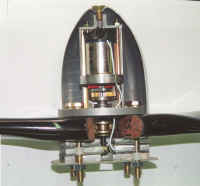|
3 A.M., August 4, 1984
- A
young man, working in starlit darkness, feverishly completes the assembly of a
homemade trike aircraft. Carefully, he points the wheels in the direction of
Vienna, thirty miles away on
the other side of the Czechoslovakian border The silence is finally broken by
the starting of a two-cylinder Trabant auto engine and the quiet swishing of the
propeller sound swells to a blare as the shadowy delta-wing moves forward across
the plowed field and lifts off. Ivo Zdarsky is on his way to becoming the first
refugee to successfully fly a homebuilt aircraft over the Iron Curtain to
freedom.
Ivo has sold over 20,000
propellers since making the one that carried him out of Communist
Czechoslovakia. He sold that one along with the rest of his trike to a West
Berlin museum that features escape vehicles. If you go to Berlin and see Ivo's trike
on display, notice the nick in one of the
(fiberglass?) prop blades. As he took off, he heard a rock hit one of the blades. Had he made the
prop from wood, he says it probably would have broken. Instead, it held together
as he flew above the trees toward a border radar station. Directly above the
station, he pushed the engine to f ull power and climbed inside the radar's
cone-shaped blind-spot to a couple of
thousand feet, then glided swiftly across the Danube River to safety in Austrian
airspace. ull power and climbed inside the radar's
cone-shaped blind-spot to a couple of
thousand feet, then glided swiftly across the Danube River to safety in Austrian
airspace.
Perhaps
the sound of that rock hitting his prop is one reason Ivo's propellers are
all made with stainless steel leading edge Their carbon-graphite composite
construction is extremely strong, as evidenced by a piece of twisted
exhaust pipe that matches the dent in an unbroken blade that was on
display at Sun-N-Fun this past April. Another indication of Ivoprop's
strength is the amount of resilient flex visible when the props under
load. They are actually designed to bend and twist for maximum efficiency
in flight. Ivo's genius and craftsmanship not only carried him safely out
of Communist Eastern Europe but soon made him one of the world's leading
manufacturers of aircraft propellers.
Ivo
(he prefers to be known by just his first name) modestly, tells how he
began making propellers in his country. After being shuttled around
Austria for six weeks to hide from the Czech version of the KGB, he was
flown to California to begin new life. Since he had started with a trike
that he built secretly in Prague and had taught himself to fly, he began to
build another in the U.S. by first making a propeller. He sold the prop at an airshow for enough profit to build two. Those provided enough money to
make four and so on. Now almost 3000 Ivoprops are built per year. They are
widely used in Europe and have been certified
in England by the C.A.A. One is even on its way to Mars as the first
interplanetary Ivoprop - it will be used to propel an airborne exploration
vehicle in the harsh Martian atmosphere.
The secret
of Ivo's success is a combination of low price and unique
features. Most
notable is a simple pitch adjustment using a torsional rod embedded in
each blade, which can be twisted by a cam in the propeller hub. Turning a
screw adjuster in the center of the hub simultaneously sets the pitch of
all blades without having to use protractors or torque wrenches to retighten hub bolts. The ground adjustable "Ultralight" model for
two-stroke engines of up to 100 horsepower weighs only six pounds with two
blades and hub ($340) or eight pounds for three blades ($460). Like the
Magnum model for engines up to 700 horsepower, as many as six blades can
be used on a single hub. unique
features. Most
notable is a simple pitch adjustment using a torsional rod embedded in
each blade, which can be twisted by a cam in the propeller hub. Turning a
screw adjuster in the center of the hub simultaneously sets the pitch of
all blades without having to use protractors or torque wrenches to retighten hub bolts. The ground adjustable "Ultralight" model for
two-stroke engines of up to 100 horsepower weighs only six pounds with two
blades and hub ($340) or eight pounds for three blades ($460). Like the
Magnum model for engines up to 700 horsepower, as many as six blades can
be used on a single hub.
Both
models are also available with electric motors, which can turn the screw
adjuster in flight. Ivo says in-flight pitch adjustment is like shifting
the gears of a car in order to save fuel, engine wear and reduce noise.
The pilot uses a switch in the cockpit similar to operating automobile
electric windows and observes the results on the engine RPM meter. The
in-flight adjustable ultralight model weighs 1.5 pounds more and costs
another $400. This torsional twist system was originally developed by Ivo
on his own ultralight trike.
An
interesting possibility with these interchangeable blades is that one can
remove one or more blades, reassemble the propeller and fly away with just
two blades. Ivo has occasionally flown his
trike to the top of desert buttes to spend a night alone in free solitude
(he also likes to fly his helicopter to remote places). He has had reason
to appreciate the versatility of his propellers when making hard landings
on rocky surfaces surrounded by sheer cliffs. A damaged blade does not
necessarily mean the aircraft is grounded in some inaccessible spot. inaccessible spot.
In response
to questions about the reliability of Ivoprops, Ivo states that the
company stands behind all of its products. Even competitors acknowledge
Ivo's integrity and fairness in replacing parts and paying for damage in
some early incidents that very likely were not his responsibility. Incorrect
torque of hub bolts results in vibrational wear around
bolt-holes and cracks near the hub-end of blades. When neglected, this can
lead to complete failure of the blade.
A service
advisory was sent out years ago detailing the sequence necessary to torque
the bolts (install, run, re-torque and check after the first 15 minute
flight). Knurling (i.e.. teeth, like on the surface of a metal-file) was
added to the crush plate that sits against the base of the blades and the
blades themselves were strengthened. Metal tape is now used across the
joint between blades so that any relative movement can be easily seen
during preflight inspections.
Ivo smiles
wryly as he explains how some genius in Austria designed a precisely 3:1
gearbox reduction drive for propellers. Some two-stroke engines mounting
three-blade props are thereby timed to fire with the blades at exactly the
same positions in the rotational circle with each impulse. The resulting
resonance compounds forces acting on the propeller blades, jerking them at
the same rate as engine RPM. Friction from Improperly torqued hub bolts
will wear the blade base and cause stress cracks from overheating.
Installation according to Ivoprop directions with the crush plate seated
correctly and hub bolts torqued to 200 inch-pounds prevents this friction.
The
latest Ivoprop development is a powered-parachute application using a
tandem pair of two-blade propellers mounted in an X-configuration of
60/120 degrees rather than 90 degree right angles like a standard
four-blade prop. The military Apache helicopter successfully uses this to
produce an effect known as hyper-acceleration. Under the right conditions,
the leading blade accelerates air into the following blade the way
multiple turbines in jet engines increase airflow to achieve more thrust.
As much as 430 pounds static thrust with a Rotax 582 engine have been
measured using the X-prop, though this varies with changes in pitch and
density altitude.
Despite all
of the attention and fierce competition Ivo has endured throughout the
years since he flew over the Iron Curtain in his home-made trike, he
remains the same quiet young man as then. Even though more Ivoprops have
been sold than any other type, he is still an unassuming free-spirit who
refuses to be molded into the image of a professional businessman.
Instead, he seems reluctant to even talk about himself or his company.
Occasionally
while talking, he looks away as though yearning to be alone in the sky soaring
toward some invisible infinity. But he becomes inspired when describing some
solitary desert flight or that lonely night of August 4, 1984,
"... I wanted
to leave (Czechoslovakia) at 3 a.m. because that is when people were least
active. So I ended up flying over Vienna for two hours like a tourist then went
looking for the international airport. I
circled the tower twice but there was nobody in the tower! Ha ha! It was still
dark then - this is the fun part - I saw a 747 being towed along a taxiway.
There was a little bit of light there, so I landed beneath the wing of this
Boeing. Enough room for two trikes! Besides, mine didn't have a pole or wires on
top but was strut-braced.. something from
having to keep a low profile when flying below electric lines. Anyway, a
mechanic came running out, yelling. I raised my hands with an expired Czech
passport and asked for political asylum. Then they were really nice to me ....
"
Ivo Zdarsky
The
name of this untamed Bohemian means more than just another airplane propeller.
Ivo represents the freedom of flight - as well as a practical way to get there.
|